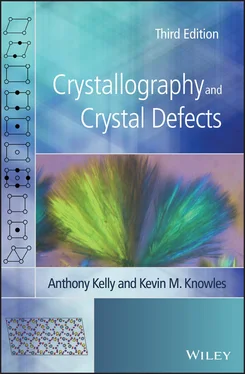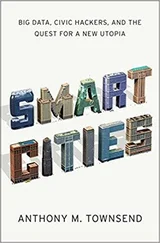In this third edition, two new chapters have been created to extend coverage on texture and interphase boundaries, so that the book can continue to be both a useful learning resource and a source reference for senior undergraduates, graduate students and researchers on core aspects of crystallography and crystal defects of particular relevance to materials science. A number of sections of the book have also been either added or extended, such as the sections on magnetic groups, the elasticity of cubic crystals, dislocations in low symmetry crystal structures, atomistic modelling of twin boundaries, the description and classification of growth twins, modern theories of martensitic transformations and the mechanism of the shape memory effect in alloys which exhibit martensitic transformations. Original source references to key crystallographic terms familiar to materials scientists such as Miller indices, Bravais lattices, the Weiss zone law, and Miller–Bravais indices and Weber indices for hexagonal and trigonal materials have been included for completeness. New questions have been added to the end of each chapter where appropriate. As with the Second Edition, brief solutions to all the questions are given after the appendices, while full worked solutions are available at the password protected Wiley Web page accompanying this book at www.wiley.com/go/kelly/crystallography3e. In addition, a number of optical and electron micrographs illustrating various aspects of the microstructure of materials which follow from the theory outlined in this book have been uploaded to this password protected Wiley Web page.
Sadly, the senior author, Anthony Kelly, died on 3 June 2014, and so the responsibility for preparing this extended third edition has fallen entirely on my shoulders as the junior author. Therefore, any typographical errors either introduced during the preparation of this third edition or missed from the first two editions of this book are ultimately my responsibility. It will be evident from reading this book, and prior editions of this book, that the book is unashamedly not an introductory textbook to crystallography and crystal defects, even though it addresses fundamental topics in materials science. However, the aim in writing this third edition has been to continue to communicate both general background knowledge and specialist research knowledge in as accessible a way as possible to an audience educated to degree level, highlighting specialist textbooks, review papers and original research papers for those interested in a deeper understanding of the various concepts introduced. The contents of this third edition have been successfully used by me for two recent week‐long courses in the GIAN program run by the Ministry of Human Resource Development of the Government of India, one on crystallography for materials scientists aimed at advanced undergraduates and new postgraduates, and a more focused one on interfaces in materials for Ph.D. students and post‐doctoral research workers. Discussions with Professors Dipankar Banerjee at the Indian Institute of Science Bangalore, Rajesh Prasad at the Indian Institute of Technology, Delhi and Anjan Sil at the Indian Institute of Technology, Roorkee arising from these GIAN courses have all been invaluable in deciding what to include in this third edition, and at what level of sophistication. Rajesh Prasad deserves a special mention for highlighting a number of typographical errors in the second edition that I have now corrected in this third edition.
There are two colour images on the front cover of this book, both related to the crystallography of devitrite, Na 2Ca 3Si 6O 16. The larger of these is a low magnification photograph of devitrite needles nucleated on the surface of a block of soda–lime–silica float glass after a heat treatment of 17 hours at 850 °C observed in transmitted polarized light with a sensitive tint at 45° to the polarizer and analyzer, which are aligned vertically and horizontally, respectively. The needles are in a thin section cut perpendicular to the surface of the glass block. The edge of the sample is below the bottom of this photograph. I am grateful to Dr Robert P. Thompson from the University of Cambridge, Department of Materials Science and Metallurgy for permission to use this photograph. The second smaller colour image of atomistic modelling of a type II twin boundary in devitrite was produced by Prof. Bin Li, now at the School of Materials Science and Engineering, Sun Yat-sen University, Guangzhou, People's Republic of China. I am also grateful to Prof. Li for permission to use this image for the front cover.
Finally, as with the second edition, it is hoped that the reader whose understanding of crystallography and crystal defects goes well beyond what is described here will nevertheless find parts where his or her knowledge has been enriched.
Kevin M. Knowles
March 2020
This book is accompanied by a companion website:
www.wiley.com/go/kelly/crystallography3e
The Website includes:
Solutions
Computer programs for crystallographic calculations
PPT slides of all figures from the book
Optical and electron micrographs illustrating various aspects of the microstructure of materials
Scan this QR code to visit the companion website.

Part I Perfect Crystals
Crystals are solid materials in which the atoms are regularly arranged with respect to one another. This regularity of arrangement can be described in terms of symmetry operations; these operations determine the symmetry of the physical properties of a crystal. For example, the symmetry operations show in which directions the electrical resistance of a crystal will be the same. Many naturally occurring crystals, such as halite (sodium chloride), quartz (silica), and calcite (calcium carbonate), have very well‐developed external faces. These faces show regular arrangements at a macroscopic level, which indicate the regular arrangements of the atoms at an atomic level. Historically, such crystals are of great importance because the laws of crystal symmetry were deduced from measurements of the interfacial angles in them; measurements were first carried out in the seventeenth century. Even today, the study of such crystals still possesses some heuristic advantages in learning about symmetry.
Nowadays the atomic pattern within a crystal can be studied directly by techniques such as high‐resolution transmission electron microscopy. This atomic pattern is the fundamental pattern described by the symmetry operations and we shall begin with it.
In a crystal of graphite the carbon atoms are joined together in sheets. These sheets are only loosely bound to one another by van der Waals forces. A single sheet of such atoms provides an example of a two‐dimensional crystal; indeed, recent research has shown that such sheets can actually be isolated and their properties examined. These single sheets are now termed ‘graphene’. The arrangement of the atoms within a sheet of graphene is shown in Figure 1.1a. In this representation of the atomic pattern, the centre of each atom is represented by a small dot, and lines joining adjacent dots represent bonds between atoms. All of the atoms in this sheet are identical. Each atom possesses three nearest neighbours. We describe this by saying that the coordination number is 3. In this case the coordination number is the same for all the atoms. It is the same for the two atoms marked A and B. However, atoms A and B have different environments: the orientation of the neighbours is different at A and B. Atoms in a similar situation to those at A are found at N and Q; there is a similar situation to B at M and at P.
Читать дальше













